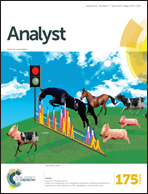Determination of boron in water samples by dispersive liquid–liquid microextraction based on the solidification of a floating organic drop coupled with a fluorimetric method
Abstract
In this work, a new, rapid and reliable method for the determination of boron in water samples by dispersive liquid–liquid microextraction based on the solidification of a floating organic drop (DLLME-SFO) prior to fluorescence spectra analysis was developed. As a result of its complexation with boric acid, the method relies on the enhancement of the fluorescence (λex = 350 nm, λem = 373 nm) of chromotropic acid. The influences of DLLME-SFO parameters, including the extraction solvent type and its volume, pH, the disperser solvent type and its volume, and salt effects were investigated. Under the optimized conditions, the limit of detection was 0.11 ng L−1, with a preconcentration factor of 86 times. The calibration curve was linear in the range of 0–40 nM. The proposed method has also been successfully applied to analyze real water samples and the relative recoveries of water samples ranged from 86.9 to 93.2%.


 Please wait while we load your content...
Please wait while we load your content...